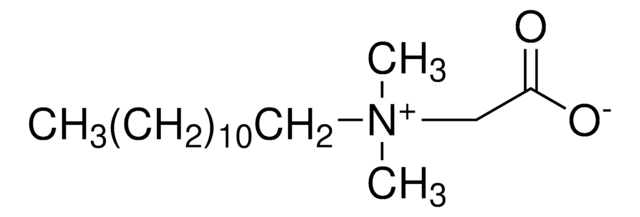H6883
3-(N,N-Dimethylpalmitylammonio)propanesulfonate
≥98% (TLC)
Synonym(s):
3-(N,N-Dimethylhexadecylammonio)propanesulfonate, 3-(Hexadecyldimethylammonio)propanesulfonate, 3-(Palmityldimethylammonio)propanesulfonate, Palmityl sulfobetaine, SB3-16
About This Item
Recommended Products
description
zwitterionic
Assay
≥98% (TLC)
mol wt
micellar avg mol wt 60,700
aggregation number
155
technique(s)
electrophoresis: suitable
mass spectrometry (MS): suitable
thin layer chromatography (TLC): suitable
conductivity
≤10 μmho per cm at 24 °C (0.05 M aqueous solution)
CMC
0.01-0.06 mM (20-25°C)
application(s)
cell analysis
SMILES string
CCCCCCCCCCCCCCCC[N+](C)(C)CCCS([O-])(=O)=O
InChI
1S/C21H45NO3S/c1-4-5-6-7-8-9-10-11-12-13-14-15-16-17-19-22(2,3)20-18-21-26(23,24)25/h4-21H2,1-3H3
InChI key
TUBRCQBRKJXJEA-UHFFFAOYSA-N
Looking for similar products? Visit Product Comparison Guide
General description
Application
Storage Class Code
11 - Combustible Solids
WGK
WGK 3
Flash Point(F)
230.0 °F - closed cup
Flash Point(C)
110 °C - closed cup
Personal Protective Equipment
Certificates of Analysis (COA)
Search for Certificates of Analysis (COA) by entering the products Lot/Batch Number. Lot and Batch Numbers can be found on a product’s label following the words ‘Lot’ or ‘Batch’.
Already Own This Product?
Find documentation for the products that you have recently purchased in the Document Library.
Customers Also Viewed
Our team of scientists has experience in all areas of research including Life Science, Material Science, Chemical Synthesis, Chromatography, Analytical and many others.
Contact Technical Service



![[2-(Methacryloyloxy)ethyl]dimethyl-(3-sulfopropyl)ammonium hydroxide 95%](/deepweb/assets/sigmaaldrich/product/structures/217/219/73c91e1c-0ee4-4b3d-bead-a6dc3d09d1da/640/73c91e1c-0ee4-4b3d-bead-a6dc3d09d1da.png)



